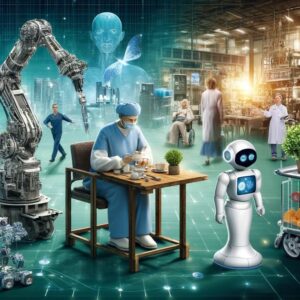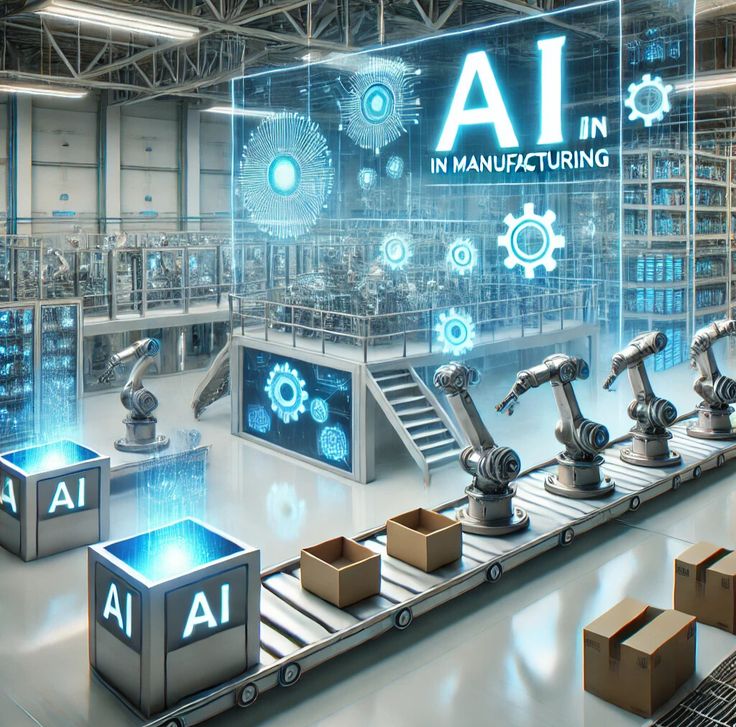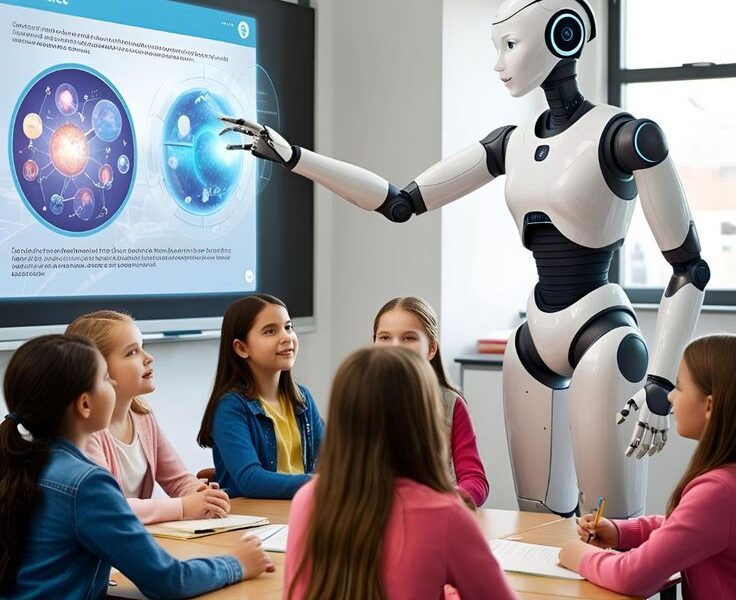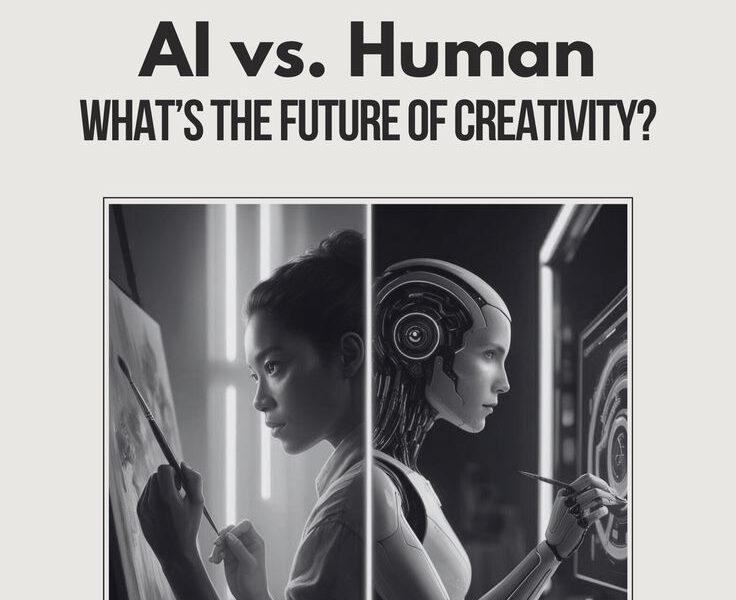**🏭 Revolutionary Changes in the Manufacturing Industry**
In technologically advanced economies, AI-powered robotics have transformed every aspect of the manufacturing industry, marking the beginning of a new era. These advanced robotic systems not only significantly increase production capacity but also establish new standards of quality, flexibility, and sustainability. In smart factories, AI-based robots continuously collect and analyze data, enabling real-time optimization of production processes. These systems automatically detect faults, predict when machines might fail, and perform preventive maintenance, significantly reducing unexpected downtime. Collaborative robots or “cobots” have enabled safe and efficient human-robot collaboration, working alongside human workers and reducing their workload. AI-powered vision systems have revolutionized quality control processes, detecting defects invisible to the human eye and inspecting every product. The use of AI in additive manufacturing has elevated 3D printing to new heights, producing complex designs with high precision. AI algorithms in supply chain management have improved logistics and inventory management, accurately predicting demand and reducing supply chain disruptions. In energy management, AI has optimized factories’ energy usage, reducing carbon footprint and promoting sustainability. The trend of customization and personalization has made AI robotics crucial, enabling large-scale production of customized products. In terms of workforce development, AI robotics has created the need for new skills, prompting educational institutions to update their curricula through upskilling and reskilling programs. All these developments together are making the manufacturing industry more efficient, flexible, and competitive, capable of meeting rapidly changing demands in global markets.

**🏥 New Era of Transformation in Healthcare Systems**
AI-powered robotics have initiated transformative changes in healthcare systems of advanced economies, elevating patient care quality, medical performance, and healthcare access to new heights. Surgical robots like the Da Vinci Surgical System have transformed how doctors assist in complex surgeries, allowing better visibility, increased precision, and minimally invasive methods, reducing patient recovery time and improving surgical outcomes. AI algorithms play a crucial role in diagnostic imaging, analyzing X-rays, MRIs, and CT scans to detect diseases at early stages, sometimes with greater accuracy than human radiologists. Robotic exoskeletons have revolutionized rehabilitation therapy, helping patients with paralysis or injuries to walk again and providing physical therapists with valuable data to monitor patient progress. In telehealth and remote monitoring, AI robots have transformed home healthcare, monitoring patients with chronic conditions, providing medication reminders, and alerting healthcare providers in emergencies. In drug discovery and development, AI has accelerated the research and development process, identifying potential drug candidates, designing clinical trials, and predicting drug side effects. In hospital logistics, AI robots have automated the delivery of medicines, laboratory samples, and medical equipment, reducing medical staff workload and minimizing care interruptions. In elderly care, AI robots have provided assistive technology for aging populations, helping with daily activities, providing social interaction, and addressing loneliness and social isolation. In mental healthcare, AI-based chatbots and virtual assistants have expanded access to therapy and counseling services, providing immediate support and identifying patients needing urgent attention for human therapists. All these developments together are making healthcare systems more efficient, patient-centered, and accessible, improving health outcomes and reducing healthcare costs.
**🚗 The Future of Transportation Infrastructure**
AI-powered robotics have reshaped transportation infrastructure in advanced economies, transforming every aspect of mobility from personal vehicle ownership to public transport and logistics. Autonomous vehicles use AI algorithms, sensors, and cameras to understand their environment, detect obstacles, and make real-time navigation decisions, potentially reducing accidents, improving traffic flow, and increasing fuel efficiency. AI-based traffic management systems have transformed urban traffic management, collecting data from various sources and adjusting signals to optimize traffic flow, avoid congestion, and improve public transport performance. Drones and autonomous delivery robots have revolutionized last-mile logistics, delivering goods quickly and at lower costs, especially in remote or congested areas. The use of AI in smart infrastructure has improved monitoring and maintenance of roads, bridges, and railway networks, detecting structural defects and recommending predictive maintenance. In public transportation, AI robots have enhanced passenger experience through automated ticketing systems, robotic guidance, and personalized information. In space transportation, AI has enabled the design and operation of reusable rockets and autonomous spacecraft, transforming space exploration and satellite deployment. In underwater transportation, AI-powered autonomous underwater vehicles (AUVs) have advanced marine research, oil and gas exploration, and underwater infrastructure inspection. In hyperloop and other futuristic transportation systems, AI has played a crucial role in designing and operating high-speed, energy-efficient transport solutions. All these developments together are making transportation infrastructure safer, more efficient, and sustainable, solving urban mobility problems and promoting economic growth.
**🔧 Industry 4.0 and Smart Production**
In Industry 4.0, AI-powered robotics have transformed manufacturing processes into an integrated, automated, and data-driven digital environment, establishing new standards of productivity, flexibility, and sustainability. The use of AI in the Industrial Internet of Things (IIoT) has elevated factory automation to new heights, where machines, equipment, and systems can communicate with each other and make autonomous decisions. Digital twins have enabled the creation of virtual models of manufacturing processes, using AI algorithms to analyze performance, predict problems, and recommend improvements. AI-based predictive maintenance has reduced machine downtime by analyzing sensor data and predicting when machines might fail, allowing operators to take preventive measures. The use of AI in additive manufacturing has improved 3D printing processes, enhancing print quality, reducing material usage, and increasing production capacity. AI algorithms in supply chain optimization have transformed supply chain management, accurately predicting demand, optimizing inventory levels, and reducing supply chain disruptions. In quality control, AI vision systems have revolutionized product inspection processes, detecting defects invisible to the human eye and inspecting every product. In human-robot collaboration, AI has enabled collaborative robots or “cobots” that can work safely with human workers and reduce their workload. In energy efficiency, the use of AI has optimized factory energy usage, analyzing energy consumption and recommending ways to reduce energy use. In workforce training, AI-based virtual and augmented reality systems have transformed how manufacturing workers are trained, providing realistic simulations and personalized training experiences. All these developments together are making the manufacturing industry more efficient, flexible, and competitive, capable of meeting rapidly changing demands in global markets.
**🏪 Transformation in Retail and E-commerce**
AI-powered robotics have reshaped retail and e-commerce sectors in advanced economies, transforming every aspect of customer experience, inventory management, and supply chain management. Autonomous checkout systems have transformed the shopping experience, allowing customers to pick products and leave stores without cashiers, reducing wait times and increasing customer satisfaction. AI-based recommendation engines have changed how businesses interact with customers, analyzing customer preference and behavior data to provide personalized product recommendations. Robotic warehouse automation has transformed fulfillment center operations, automating product selection, stocking, and packaging processes, increasing efficiency and reducing costs. The use of AI in last-mile delivery has improved delivery processes, optimizing delivery routes, predicting traffic conditions, and reducing delivery times. AI algorithms in inventory management have transformed stock level management, accurately predicting demand, preventing stockouts, and reducing overstocking. In customer service, AI-based chatbots and virtual assistants have changed customer interaction methods, providing instant responses, order status information, and return process assistance. In-store robotics have transformed traditional retail store operations, restocking products, cleaning stores, and providing customer guidance. The use of AI in virtual try-on and augmented reality experiences has enhanced online shopping experiences, allowing customers to try products in virtual environments, reducing return rates and increasing customer satisfaction. AI algorithms in dynamic pricing have transformed pricing methods, analyzing market conditions, customer behavior, and competitor pricing to adjust prices in real-time. The use of AI in supply chain visibility has transformed supply chain management, monitoring every stage of the supply chain, detecting disruptions, and recommending improvements. All these developments together are making retail and e-commerce sectors more efficient, customer-focused, and competitive, enhancing customer experience and improving business performance.
**🌳 Contribution to Environmental Sustainability**
AI-powered robotics have played a significant role in achieving environmental sustainability in advanced economies, transforming every aspect of natural resource usage, waste management, and carbon emission reduction. The use of AI in renewable energy has improved solar and wind energy system operations, predicting weather conditions, optimizing energy production, and ensuring grid stability. AI algorithms in energy management have optimized energy usage in buildings and industrial facilities, analyzing energy consumption and recommending ways to reduce energy use. AI-based sorting systems in waste management have revolutionized recycling processes, detecting different waste materials and separating them, improving waste flow and reducing landfill waste. In precision agriculture, AI robots have transformed farming practices, monitoring plant health, optimizing pesticide use, and reducing water usage, decreasing farming’s environmental impact. The use of AI in water management has transformed water resource management methods, monitoring water quality, detecting leaks, and optimizing water usage. AI-based sensors in air quality monitoring have transformed air pollution monitoring methods, detecting pollution sources and recommending air quality improvements. The use of AI in sustainable transportation has reduced environmental impacts of transport systems, improving fuel efficiency, optimizing traffic flow, and promoting electric vehicle use. In circular economy, AI robots have transformed product lifecycle management methods, disassembling products, recycling parts, and optimizing material flow. The use of AI in environmental monitoring has transformed ecosystem monitoring methods, detecting deforestation, biodiversity loss, and climate change impacts. AI algorithms in climate modeling have transformed climate change modeling methods, accurately predicting climate change effects and recommending mitigation measures. All these developments together are playing a crucial role in achieving environmental sustainability, ensuring natural resource conservation, waste reduction, and carbon emission reduction.
**🎓 Transformation in Education and Skill Development**
AI-powered robotics have reshaped education and skill development sectors in advanced economies, transforming every aspect of teaching, learning, and skill development. AI algorithms in personalized learning have transformed students’ learning experiences, analyzing student performance data and providing personalized educational content and instructions. Intelligent tutoring systems have transformed how students receive instructions, monitoring student progress and providing real-time feedback. Educational robotics have enhanced students’ learning experiences, introducing students to programming, robotics, and engineering concepts. The use of AI in virtual and augmented reality has enabled immersive learning experiences, allowing students to interact with educational content in virtual environments. AI algorithms in automated assessment have transformed evaluation processes, automatically reviewing student work and providing detailed feedback. The use of AI in curriculum development has transformed educational curriculum design methods, analyzing student performance data and recommending curriculum improvements. AI-based tools in teacher support have reduced teachers’ workload, automating administrative tasks and providing teaching insights. The use of AI in lifelong learning has transformed adult education methods, providing personalized learning paths and skill development opportunities. In special education, AI robots have provided educational support for students with special needs, assisting with communication, social skills, and academic performance. The use of AI in global education has expanded access to educational content, overcoming language barriers and providing personalized educational experiences. All these developments together are making education and skill development sectors more efficient, personalized, and accessible, improving student learning outcomes and promoting skilled workforce development.
**🏛️ New Requirements for Governance and Policy**
AI-powered robotics have presented new requirements for governance and policy sectors in advanced economies, transforming every aspect of laws, regulations, and ethical frameworks. The use of AI in ethical guidelines has influenced the development of ethical use principles for artificial intelligence, ensuring transparency, accountability, and justice principles. AI robots in regulatory frameworks have transformed how regulations are designed and implemented, ensuring safe and ethical use of AI systems. The use of AI in data privacy has influenced data protection law development, protecting personal data and preventing misuse. AI robots in liability laws have influenced liability law development, determining responsibility for damages caused by AI systems. The use of AI in intellectual property has influenced intellectual property law development, determining rights for works created by AI. AI robots in international cooperation have transformed international cooperation methods, promoting international collaboration to address global AI challenges. The use of AI in public policy has transformed public policy processes, enabling data-driven policy development. AI robots in transparency and accountability have influenced transparency and accountability mechanism development, ensuring explanation and audit of AI system decisions. The use of AI in public engagement has transformed public consultation processes, involving citizens in AI development and use. AI robots in future governance have influenced future governance model development, exploring new ways of effective governance with AI. All these developments together are making governance and policy sectors more effective, transparent, and accountable, ensuring safe and ethical AI use and protecting public interest.


